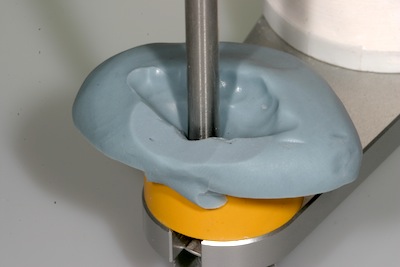How to Make a Custom Incisal Guide Table
Once the decision is made to make a custom incisal guide table, the following sequence of steps should be followed. Determine if you are going to restore the patient in a seated condylar position (CR) or in maximum intercuspal position (MIP). If the two positions do not coincide, decide if you want to perform an equilibration.
- Make accurate impressions and casts of the maxillary and mandibular teeth.
- Take a facebow transfer.
- Take a protrusive bite registration record.
- Mount the maxillary cast with the facebow jig, and then hand-articulate the mandibular cast to mount it to the upper. The protrusive record is used to set the condylar inclinations.
- The materials that can be used for the custom incisal guide table are as listed below. Place a small amount of the material approximately 1.0 cm thick onto a stock incisal table. If Triad is used, it is light cured after the movements are all completed. All of the other materials are auto-curing, so you must move efficiently to avoid distortions.
- Triad (Dentsply)
- GC Pattern Resin
- Duralay
- Sil-Tech (Ivoclar) – firm silicone putty
- Lubricate the incisal guide pin with Vaseline so it glides smoothly through the material you have selected.
- Close the articulator with condyles locked so the incisal guide pin penetrates through the material and strikes the top of the table. This establishes the home position which represents maximum intercuspation.
- Open the articulator and release the condylar locks. Position the casts so the incisal edges are now touching as in straight protrusive position. Confirm the teeth are touching as you move the maxillary cast to the home position. This establishes the straight protrusive incline on the custom incisal guide table.
- Open the articulator and position the casts in a pure right lateral edge-to-edge position. Move the maxillary cast to the home position making certain the teeth are touching. This records the right lateral incline on the guide table. Repeat for the left side. The pathways have been recorded after completing the protrusive, right and left, movements.
- Now record all the lateral protrusive movements by moving the maxillary cast. Repeated movements will be necessary to establish a smooth custom guide table.
After completion of these steps, all of the functional movement patterns have been recorded for this patient. If the patient goes into cross-over during parafunction, this will need to be addressed in the new occlusal scheme.
SPEAR STUDY CLUB
Join a Club and Unite with
Like-Minded Peers
In virtual meetings or in-person, Study Club encourages collaboration on exclusive, real-world cases supported by curriculum from the industry leader in dental CE. Find the club closest to you today!

By: Robert Winter
Date: June 5, 2013
Featured Digest articles
Insights and advice from Spear Faculty and industry experts



